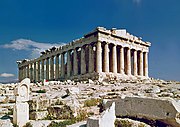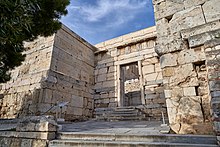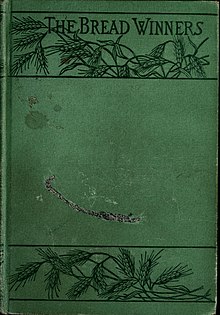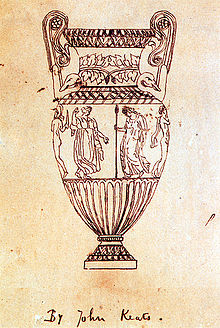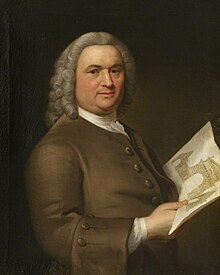Portal:The arts
T H E A R T S P O R T A L
The arts or creative arts are a vast range of human practices of creative expression, storytelling, and cultural participation. The arts encompasses multiple diverse and plural modes of thinking, doing, and being, in an extremely broad range of media. Both dynamic and a characteristically constant feature of human life, they have developed into innovative, stylized, and sometimes intricate forms. This is often achieved through sustained and deliberate study, training, and/or theorizing within a particular tradition, across generations, and even between civilizations. The arts are a vehicle through which human beings cultivate distinct social, cultural, and individual identities while transmitting values, impressions, judgements, ideas, visions, spiritual meanings, patterns of life, and experiences across time and space.
Prominent examples of the arts include: visual arts (including architecture, ceramics, drawing, filmmaking, painting, photography, and sculpting), literary arts (including fiction, drama, poetry, and prose), and performing arts (including dance, music, and theatre). They can employ skill and imagination to produce objects and performances, convey insights and experiences, and construct new environments and spaces.
The arts can refer to common, popular, or everyday practices as well as more sophisticated, systematic, or institutionalized ones. They can be discrete and self-contained or combine and interweave with other art forms, such as the combination of artwork with the written word in comics. They can also develop or contribute to some particular aspect of a more complex art form, as in cinematography. By definition, the arts themselves are open to being continually redefined. The practice of modern art, for example, is a testament to the shifting boundaries, improvisation and experimentation, reflexive nature, and self-criticism or questioning that art and its conditions of production, reception, and possibility can undergo.
As both a means of developing capacities of attention and sensitivity and as ends in themselves, the arts can simultaneously be a form of response to the world and a way that our responses and what we deem worthwhile goals or pursuits are transformed. From prehistoric cave paintings to ancient and contemporary forms of ritual to modern-day films, art has served to register, embody, and preserve our ever-shifting relationships to each other and to the world. (Full article...)
Featured articles -
Featured picture
Did you know...
- ... that Frank Lloyd Wright's textile block work, Storer House (pictured), was restored in the 1980s by Joel Silver, producer of the films Die Hard and The Matrix?
- ... that Swiss illustrator Albert Lindegger was responsible for murals at the headquarters of the cantonal police and the crematorium in Berne?
- ... that U.S. Presidents Lyndon B. Johnson and Harry S. Truman once lived in the Kennedy-Warren Apartment Building?
In this month
- 9 June 1904 – The London Symphony Orchestra, conducted by Hans Richter, plays its first concert
- 18 June 1964 – Italian painter Giorgio Morandi, whose still lifes and landscapes were noted for their tonal subtlety, dies in Bologna at the age of 73
- 20 June 1703 – The Love Suicides at Sonezaki by Chikamatsu Monzaemon, often considered the greatest Japanese dramatist, receives its first performance
- 24 June 1924 – Efua Sutherland, a foundational figure in modern Ghanaian drama, is born in the Cape Coast region of Ghana
- 29 June 1861 – Elizabeth Barrett Browning (pictured), one of the most prominent poets of the Victorian era, dies in Florence at the age of 55
News
- August 5: DaBaby Levitating remix losing US radio audiences after the rapper's comments on HIV/AIDS
- June 11: Taylor Swift's Evermore records biggest sales week of the year as it returns to No 1 on album chart
- May 27: Olivia Rodrigo's song good 4 u debuts at No 1 on US Billboard Hot 100 chart
- May 25: 'Rock and roll never dies': Italy wins Eurovision after 30 years
- February 10: Disney to shut down Blue Sky Studios, animation studio behind 'Ice Age'
Featured biography
William Bruce was a Scottish gentleman-architect, "the effective founder of classical architecture in Scotland", as Howard Colvin observes. A key figure in introducing the Palladian style into Scotland, he has been compared to the pioneering English architects Inigo Jones and Christopher Wren, and to the contemporaneous English introducers of French style in domestic architecture Hugh May and Roger Pratt. Bruce played a role in the Restoration of Charles II, carrying messages between the exiled king and General Monck, and was rewarded with lucrative official appointments, including that of Surveyor General of the King's Works in Scotland, effectively the "king's architect". His patrons included the Duke of Lauderdale, the most powerful man in Scotland at the time. Despite his lack of technical expertise, he worked with competent masons and professional builders, to whom he imparted a classical vocabulary; thus his influence was carried far beyond his own aristocratic circle. Beginning in the 1660s he built and remodelled a number of country houses, including Thirlestane Castle for the Duke of Lauderdale, and Hopetoun House. Among his most significant work was his own Palladian mansion at Kinross, built on the Loch Leven estate which he had purchased in 1675. (Full article...)
Featured audio
Selected quote
| “ | In my view, the composer, just as the poet, the sculptor or the painter, is in duty bound to serve Man, the people. He must beautify human life and defend it. He must be a citizen first and foremost, so that his art might consciously extol human life and lead man to a radiant future. Such is the immutable code of art as I see it. | ” |
Categories
WikiProjects
Parent project
Descendant projects
Related portals
Things you can do
- Check the recent changes page for improvements, other changes, and vandalism to these articles
- Article requests: Requests articles (arts and entertainment)
- Deletion discussions: Listed at Wikipedia:WikiProject Deletion sorting/Arts
- Expand: check Visual arts stubs to expand
- Notability: Articles with notability concerns, listed at WikiProject Notability
- Requested pictures: Arts topics, requested pictures

